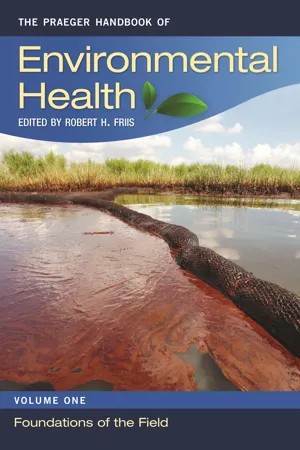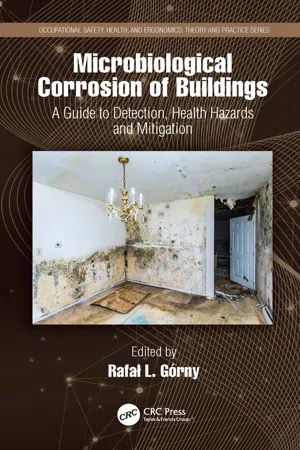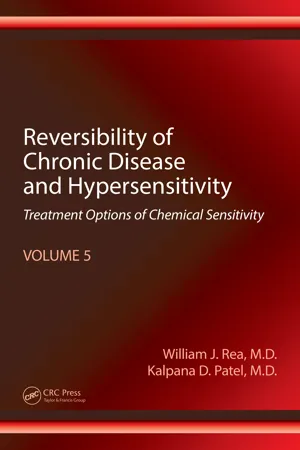Biological Sciences
Mold Health Effects
Mold health effects refer to the negative impact that exposure to mold can have on human health. These effects can range from mild symptoms such as sneezing and coughing to more severe reactions such as asthma attacks and respiratory infections. Prolonged exposure to mold can also lead to long-term health problems.
Written by Perlego with AI-assistance
Related key terms
Related key terms
1 of 4
Related key terms
1 of 3
3 Key excerpts on "Mold Health Effects"
- eBook - ePub
The Praeger Handbook of Environmental Health
[4 volumes]
- Robert H. Friis, Robert H. Friis, Robert H. Friis(Authors)
- 2012(Publication Date)
- Praeger(Publisher)
For the majority of adverse health outcomes related to mold exposure, a higher level of exposure to living molds or a higher concentration of allergens on spores and mycelia results in a greater likelihood of illness. However, no standardized method exists to measure the magnitude of exposure to molds. In addition, data are limited about the relation between the level of exposure to mold and how that causes adverse health effects and how this relation is affected by the interaction between molds and other microorganisms and chemicals in the environment. For this reason, it is not possible to sample an environment, measure the mold level in that sample, and make a determination about whether the level is low enough to be safe or high enough to be associated with adverse health effects.People affected by major hurricanes or floods probably will be exposed to a wide variety of hazardous substances distributed by or contained within the floodwater. This chapter does not provide a comprehensive discussion of all such potential hazards; such situations will of necessity require case by case evaluation and assessment. Guidance has been provided by the CDC for such issues in a number of documents, including NIOSH Hazard Based Interim Guidelines: Protective Equipment for Workers in Hurricane Flood Response9 and Protect Yourself from Chemicals Released during a Natural Disaster.10Factors That Cause Disease from Mold
Numerous species of mold cause infection through respiratory exposure. In general, persons who are immunosuppressed are at increased risk for infection from mold.11 Immunosuppression can result from immunosuppressive medication, from medical conditions and diseases that cause it, or from therapy for cancer that causes transient immunosuppression. Although certain species of mold cause infection,5 8, 11 many mold species do not. Infections from mold might be localized to a specific organ or disseminated throughout the body.Many of the major noninfectious health effects of mold exposure have an immunologic (i.e., allergic) basis.6 Exposure to mold can sensitize persons, who then might experience symptoms when re-exposed to the same mold species. For sensitized people, hay fever symptoms and asthma exacerbations are prominent manifestations of mold allergy.6 Although different mold species might have different propensities to cause allergy, available data do not permit a relative ranking of species by risk for creating or exacerbating allergies. In addition, exposure to beta glucans might have an inflammatory effect on the respiratory system.12 - eBook - ePub
Microbiological Corrosion of Buildings
A Guide to Detection, Health Hazards, and Mitigation
- Rafał Górny, Rafal L. Górny(Authors)
- 2020(Publication Date)
- CRC Press(Publisher)
Figure 3.1 ). Such a situation from both medical and epidemiological points of view makes precise estimation of the number of adverse cases (directly related to microbiological contamination of premises or resulting from the presence of water damage) very complicated.FIGURE 3.1 Health effects and diseases resulting from indoor dampness and mould exposure.3.2 Health Significance of Microbiological Hazards
3.2.1 Allergic Reactions
Microorganisms colonising water-damaged buildings play an important role in the pathogenesis of many allergic diseases, including asthma, allergic alveolitis, allergic rhinitis, allergic conjunctivitis and sinusitis, allergic inflammation of the nasal mucosa, sarcoidosis and allergic bronchopulmonary aspergillosis. Allergic reactions to moulds are quite common and can affect about 20% of the world’s population (3–10% in Europe). The most allergenic fungi include those of Alternaria , Aspergillus , Cladosporium , Mucor , Penicillium and Trichoderma genera [Górny and Dutkiewicz 2002; Denning et al. 2014; Kurup et al. 2002; Hurraß et al. 2017]. Hypersensitivity to fungal allergens is a significant risk factor for the development of severe bronchial asthma. It is estimated that, among 22 million people with asthma, about 5 million cases are caused by poor living conditions, in particular increased humidity and associated exposure to moulds [Mudarri and Fisk 2007]. According to the ‘Healthy Homes Barometer 2017’ report, about 2.2 million Europeans suffer from asthma caused by their living conditions [Rasmussen et al. 2017].The latest studies indicate the relationship between exposure to moulds in early childhood and the development of atopic diseases, including asthma, later in life. Increased humidity and visible traces of moulds or their odours in the building are considered to be determinants of the development of asthma and other respiratory or skin diseases in exposed individuals [Platt et al. 1989; Koskinen et al. 1995; Meklin et al. 2002; Quansah et al. 2012; Karvonen et al. 2015; Oluwole et al. 2016; Moses et al. 2019; Wang et al. 2019]. The results of a meta-analysis conducted by Sharpe et al. [2015] suggest that the presence of fungi in the air, in particular of Aspergillus , Penicillium , Cladosporium and Alternaria genera, exacerbates the existing symptoms of asthma in children and adults. In some patients with asthma, the inhaled conidia Aspergillus fumigatus (commonly found in damp houses) are not effectively eliminated from the airways and form colonies growing in the bronchial lumen. This may lead to the development of allergic bronchopulmonary aspergillosis (ABPA), a very serious disease caused by hypersensitivity to the antigens of this fungus. In a medical history, ABPA is very rarely diagnosed without bronchial asthma, which results in the lack of data on the incidence of the disease in the general population [Denning et al. 2014; Shah and Panjabi 2014]. In turn, hypersensitivity pneumonitis (HP) is a complex of diseases caused by inhalation exposure to microbial antigens including fungi such as Aspergillus , Penicillium , Cladosporium , Trichosporon and Aureobasidium - eBook - ePub
Reversibility of Chronic Disease and Hypersensitivity, Volume 5
Treatment Options of Chemical Sensitivity
- William J. Rea, Kalpana D. Patel(Authors)
- 2017(Publication Date)
- CRC Press(Publisher)
CBS Laboratory Manual Series 2 , p. 390. Utrecht, The Netherlands: CBS-Fungal Biodiversity Centre.3. American Industrial Hygiene Association (AIHA): Facts about Mold. December 2011. Accessed February 12, 2013. http://www.aiha.org/newspubs/newsroom/Documents/Facts%20About%20Mold%20December%202011.pdf4. Curtis, L., A. Lieberman, M. Stark, W. Rea, M. Vetter. 2004. Adverse health effects of indoor molds. J. Nutr. Environ. Med. 14(3):1–14.5. Kurup, V. P., H. D. Shen, H. Vijay. 2002. Immunotherapy of fungal allergens. Int. Arch. Allergy Immunol. 129:181–188.6. Prester, L. 2011. Indoor exposure to mold allergens. Arh. Hig. Rada. Toksikol. 62:371–380.7. Rea, W. J. 1997. Environmentally triggered small vessel vasculitis. Ann. Allergy 38:245–251.8. Institute of Medicine. 2000. Clearing the Air. Asthma and Indoor Exposures . Washington, DC: The National Academic Press. https://doi.org/10.17226/96109. Rea, W. J., K. Patel. 2014. Reversibility of chronic degenerative disease and hypersensitivity, V. II. In The Effects of Environmental Pollutants on the Organ Systems . Boca Raton, FL: CRC Press, Taylor & Francis Group, Chapter 7, p. 542.10. Rea, W. J. 1994. Chemical sensitivity. In Sources of Total Body Load . Vol. 2. Ch. 17. Boca Raton, FL: CRC Press, pp. 1031–1039.11. Rall, T. W., L. S. Schleifer. 1985. Drugs affecting uterine motility. In The Pharmacological Basis of Therapeutics , A. G. Gilmann, L. S. Goodman, T. W. Rall, F. Murad, Eds., p. 938. New York: Macmillan.12. Hintikka, E. L., M. Salkinoja-Salonen. 1997. Bacteria, molds, and toxins, in water-damaged building materials. Appl. Environ. Microbiol. 63:387–393.13. Nielsen, K. F., S. Gravesen, P. A. Neilsen. 1999. Production of mycotoxins on artificially and naturally infested building materials. Mycopathologia 145:43–56.14. Randolph, T. G. 1962. Human Ecology and Susceptibility to the Chemical Environment . Springfield, IL: C.C. Thomas.15. American Society for Heating, Refrigeration, and Air-Conditioning Engineers (ASHRAE): Limiting Indoor Mold and Dampness in Buildings Position Document. June 27, 2012. Accessed February 12, 2013. https://www.ashrae.org/File%20Library/docLib/About%20Us/PositionDocuments/Position-Document---Limiting-Indoor-Mold-and-Dampness-in-Buildings.pdf
Index pages curate the most relevant extracts from our library of academic textbooks. They’ve been created using an in-house natural language model (NLM), each adding context and meaning to key research topics.
Explore more topic indexes
Explore more topic indexes
1 of 6
Explore more topic indexes
1 of 4


